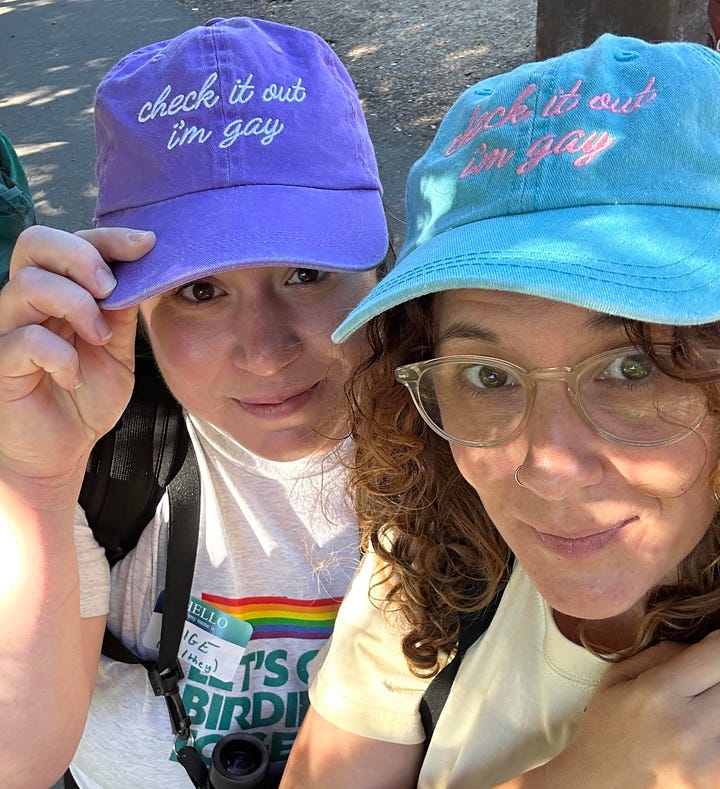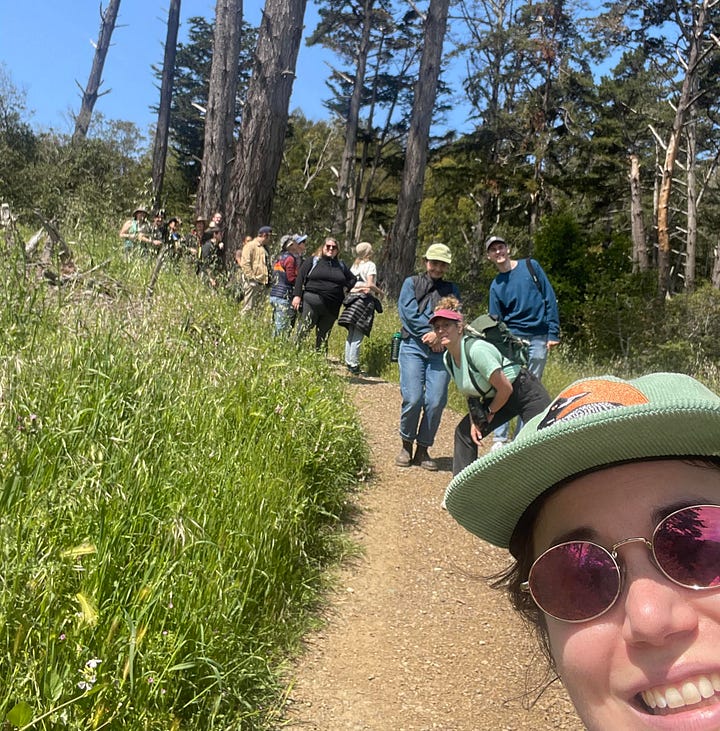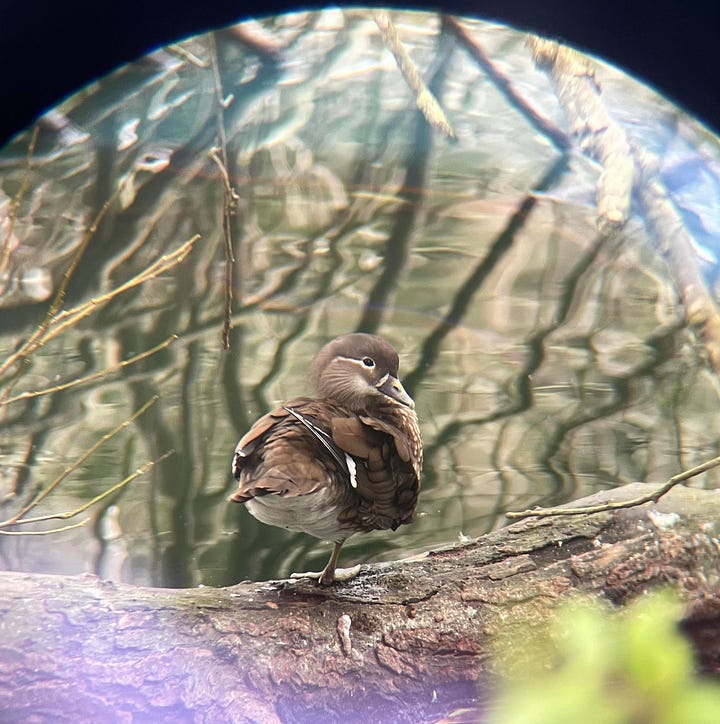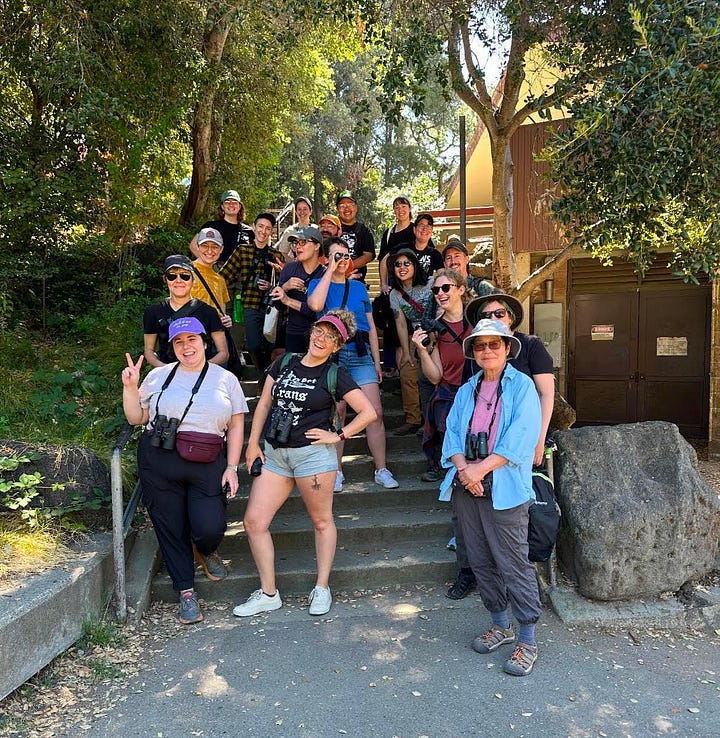December 2024: Yuletide Edition
The weather outside is frightful... so bundle up, because we're going out in it.
In this month’s issue:
Bay Area birder Paige Pritchard explains how bird watching can help you make friends (particularly those without feathers)
It’s dark at 4:30 p.m., but not for long — here’s how to honor the shortest day of the year
Feeling crafty? This yuletide project will spread seasonal cheer to your feathered friends
How frogs survive frosty winter temps (anyone want a frozen frog pop?)
Plus a few other nature notes.
Hello, friends!
Somehow, we’ve made it. We’ve walked the hills and valleys of this year and arrived at December, the last — and perhaps most hectic — month. Have you started shopping and wrapping all those presents yet? How slammed is your calendar with holiday parties and tasks that urgently need completion before the 31st? I’ve got another thing to add to your list, and you already know what I’m going to say: you have to go outside, yes, even in winter.
December is full of commitments… but also magic. There’s the kind we create for others (charity, gifts, acts of kindness) and tiny moments of joy kept just for ourselves (quietly scarfing down a European cookie tin in the kitchen so your children don’t hear and you don’t have to share). Then, there’s Mother Nature, who has quietly crafted a few sparkling gifts for us to wonder at, if only we head outdoors to find them.
Outside this month, you might notice how the woods are so quiet that the sound of squirrel claws against trees echoes as they dash back to their cozy burrows. How snow glistens in the soft sunlight and catches your attention. The pop of color American holly berries rosily provide against the desaturated woods.
The winter holiday season may also be one of the most emotionally loaded times of year, filled with excitement and joy, but also memories of those no longer with us, or painful reflections of a difficult year soon to pass. That’s a lot of emotion for any one human to reconcile, you know. A little time away from crowded parties, spent breathing in the cool air and observing the world around us, can provide a moment to acknowledge those feelings and sit with them.
However you choose to mark the last weeks of the year, I send you cheerful season’ greetings. This December, I hope your stockings are full, your heart is light, and your hiking boots lace up tightly on your next outdoor adventure.
This month, outdoors
A few ideas of how you can enjoy what nature has scheduled for December
🦆Finding Friends Where the Wild Fowl Fly
On Christmas Day 1900, ornithologist Frank M. Chapman convinced 27 fellow birders to try something new: counting birds instead of shooting them. December 25 was often reserved for “side hunts” during the 1800s, a game that involved venturing into nature in teams with the goal of shooting as many birds and mammals as could be flushed out into the open. But at the start of a new century — the same one that would soon see passenger pigeons and Carolina parakeets entirely disappear — Chapman hoped to usher in a new holiday tradition, one that would potentially protect flocks across North America, or at least collect data about their well-being.
That holiday, Chapman and his crew of counters led the first Christmas Bird Census, documenting nearly 90 species of birds stretching from the California coast to Toronto. Their efforts would become the progenitor of an annual event still hosted by the Audubon Society today.
More than 120 years later, birders across North America gather in mid-December and January, banding together in designated areas to watch for avian activity. Now known as the Christmas Bird Count, Chapman’s inspired idea has grown into an incredibly useful tool for assessing bird populations year after year. When paired with other field surveys, these counts alert ornithologists and naturalists to waxing and waning bird populations. Unlike other Audubon surveys, the Christmas Bird Count requires heading out to specifically selected sites — you may or may not have one nearby, and slots are limited to a number of participants, making the census somewhat inaccessible.
If the idea of meeting up with friends this time of year to not murder birds intrigues you, but participating in the Christmas Bird Count isn’t possible, you’re in luck. Birding groups across the country do just that, all year long. According to Paige Pritchard, co-lead of Queer Birders Bay Area, bird watching is a fantastic way to meet new people wherever you call home. The group, which she organizes with fellow birder Alyssa Winn, gathers monthly at different spots around California’s San Francisco Bay.
“It’s just so fun meeting the folks who show up,” Paige says. “It’s birding, but the priorities are to be in community outside. To learn from each other.”


Paige grew up in southeast Missouri where common backyard birds such as blue jays, cardinals, and robins (a favorite) inspired an adult interest in birding. “There was a certain level of birding I was always doing, but I didn’t know it,” she says. One of the earliest bird-watching partners was their grandmother, Ruth, who would point out birds at backyard feeders, naming off species and alerting Paige to the calls. “I always enjoyed seeing her know the names of things,” Paige recalls.
A cross-country move to California pushed Paige into birding as an adult because it offered a way to explore the area. “There’s a whole new flora and fauna here,” she says, mentioning an affection for the coastal birds that swoop over the bay. “The brown pelicans just blew my mind. To this day, they’re some of my favorites. They’re like dinosaurs — just these massive, beautiful, dramatic birds that fly over and look like pterodactyls.”
In early 2022, Paige met fellow birder Alyssa Winn through an organized bird walk, and by the end of the year the duo launched Queer Birders Bay Area’s (QBBA) first group meetup. (Paige points to Alyssa, who has birded regularly for the past five years, as the driving force behind the group’s creation.) Sharing their monthly planned outings through Instagram and Meetup has helped QBBA grow, bringing together a diverse crowd of birding enthusiasts.
“There’s a lot of importance in being outside together, and visibility in community,” Paige says, pointing to the historical sidelining of LGBTQ+ folks from many activities and spaces. “We want to create intergenerational friendships and connections. Queer Birders has been so great for that. We’ve had people bring their teenagers. We’ve had people across multiple generations who have been birding in the Bay Area for decades, and are just a wonderful wealth of knowledge. We have people who are studying ornithology and can just rattle things off.”


QBBA welcomes birders of all levels and abilities — one of the group’s core tenets is learning from one another. Meetups are often organized around public transportation and with physical access in mind. There’s also a focus on “cross-pollinating” with other outdoor groups to expand recreational opportunities. In 2023, QBBA collaborated with Fat People Hiking Bay Area, a group that encourages outdoor exploration for all bodies regardless of weight, and is looking for more groups to collaborate with in the future.
“It’s so hard these days to make friends,” Paige says. “There’s that bridge you have to cross with ‘What’s your number?’ or ‘What’s your Instagram?’” That’s one reason why QBBA also runs a Discord group connecting California birders, helping them move from online chats to real-life outdoor plans.
“It’s really been one of the most rewarding things,” Paige says about using QBBA to build friendships and bolster a sense of community in the Bay Area. The birds are fantastic, too.
5 Tips For Finding Your Community of Birders (And What To Do When You Get Out There Together)
Start squawking (aka put out a call to collaborate). You don’t have to join a birding-specific group to spend time looking at fowl, though collaboration between groups you’re already in can develop fledgling interests and friendships. “I love this as an avenue for connections to be made, and for people to plug into new spaces,” Paige says. Queer Birders Bay Area is always looking for new outdoor groups to work with, and interested organizations are encouraged to reach out.
Don’t feel that you need to be an expert. Knowledge can be a stumbling block to getting started with bird watching, though this hobby doesn’t require you to memorize every bird in your region. “If you go outside and look at a bird, you are bird watching,” Paige says. At the same time, give lesser experienced birders in your group a chance to learn by using one of QBBA’s rules: pause before calling out a bird ID so that everyone has a chance to observe and identify.
Have patience, young padawan. One of the hardest parts of bird watching is waiting for the birds to appear. Being able to sit still and observe your surroundings gives you the chance to see birds you may have missed. “It’s a hard skill to foster, so focus on that,” Paige says.
Let technology give you a helping hand. Paige recommends Merlin Bird ID — what she calls “Shazam for birds.” Another great app, eBird, can help you find birding hotspots.
Don’t stress about splurging on gear. Getting started doesn’t require more than your eyes and ears. While binoculars, books, and other items are often promoted to birders, Paige advises that you don’t need them to get started. However, many libraries and birding groups offer gear kits you can check out before your next adventure, so be sure to look for those free resources before filling your shopping cart.
You don’t have to be an ornithologist like Frank M. Chapman to enjoy our feathered friends this holiday season, but you can take a page from his book by simply gathering with friends and watching birds. You might just walk away with something deeper than an afternoon in the outdoors.
🌞 There Goes The Sun (And It’ll Be Alright)
In the weeks leading up to the winter solstice — marked Dec. 21 this year — I find my trusty SAD lamp reaches BFF status. If this were 2006, that little lightbox would reign supreme in my MySpace Top 8 for the foreseeable future. The decreasing hours of sunlight really take a toll, and while I crave the cozy comfort of winter, I can’t deny that I’m dreaming of longer sunny days.
The winter solstice marks the deepest part of our short daylight hours in North America, holding space for the longest night of the year. We’re left to peer out into the darkness at its most extreme grip on our days, waiting for the sun to claw back possession of our time as we eek toward the summer solstice in June.
Despite how gloomy it may feel, there’s something uniquely beautiful about this time of year. Solstices remind me there’s a time for work and play, rest and calm. I think it’s worth recognizing and honoring that balance of nature. Here’s a few ideas of how you can salute the day, even if you too are taking a daily vitamin D supplement and spending 15 minutes each morning in front of a glowing box.
Take a nature walk. It’s easy to hide away indoors this time of year — I personally love to rot on the couch under a blanket from December through March, rewatching Outlander and knitting mittens. However, exploring the woods this time of year offers a glimpse at nature in its most dormant state. Wooded areas often feel more delicate and quiet; without leaves on the trees to block sight and sound, you can see farther and hear the softer skitters masked in the bustling seasons.
Light a candle. If you, too, have uttered “It’s getting dark so early now,” the only solution is to give yourself a little more light. Simply lighting a candle at dusk on the solstice, as the longest night of the year begins, serves as a small reminder that brighter days are ahead.
Watch the sunrise at Stonehenge. You don’t need to book a red-eye flight to get a view of the sun slowly glowing over those famous stones. British history non-profit English Heritage livestreams each solstice sunrise at Stonehenge. Another option: brew yourself an early cup of coffee and watch the view from your own balcony or backyard.
Commit to a little rest. Seriously. The algorithms have been encouraging me to undertake a “winter arc” and while it sounds tempting, I want to advocate for the opposite: it’s time to pause. The idea that we must constantly be moving, growing, working towards a prescribed set of goals invalidates the very real need our bodies have for rest. The solstice is a natural reminder that all things in life require give and take — and in this season where nature has slipped into a long slumber, it doesn’t hurt to add sleep and softness to the top of your winter season to-do list.
Arrivals, departures, and other nature notes
What to look for on this month’s outdoor adventures
Get the birds rockin’ around your backyard trees. Each fall, I horde up pine cones not because I’m building a Baba Yaga apothecary, but because I need them for feeding my bird friends once winter settles in. In an effort to thank the backyard birds who give me joy all throughout the year, I undertake the childhood craft of making pine cone feeders with just a handful of household supplies: pine cones, peanut butter, birdseed, and twine. It’s as simple as tying a string to each pine cone before slathering the shell in peanut butter and rolling the entire contraption in birdseed. Afterwards, I hang them on the nearest tree for a little holiday cheer. (No pine cones to spare? Citrus peels work, too.)
“That ain’t the friggin’ Christmas Star. It’s a light on the sewage treatment plant.” You’ll have more luck spotting shooting stars this month than Clark Griswold in National Lampoon's Christmas Vacation. The Geminids meteor shower, which is active each year from mid-November through Christmas, is almost at its peak. This astronomical event is considered one of the best meteor showers each year because of its bright and frequent flurry that has reappeared since 1833. You may see an astonishing 150 meteors per hour when the Geminids shower crests Dec. 13–14.
If you’re cold, they’re cold. But don’t bring them inside. If the yuletide deities could grant me one wish, it would be this: Please stop my children from bringing frogs and toads into the house. Sure, it’s cold out there, but these little amphibians are built for the weather. Despite seeming somewhat fragile, frogs can be found as far north as the Arctic Circle, surviving harsh conditions with a cozy winter hibernation. Many North American frogs escape the frosty temperatures by burrowing deep into the ground, within thick logs, or under ample leaf litter. They also have another trick: frogs produce large amounts of glucose, which works like antifreeze to protect their organs from cold damage as they literally freeze into hardened frogsicles. Miraculous.
I’m dreaming of a green Christmas. Ever notice how one of the last remaining bits of greenery this time of year is found along rocks and trees? Mosses are amazingly equipped to survive the same freezing temperatures that push other flora into winter dormancy. These fuzzy low-growers belong to the bryophyte family, some of the oldest plants on Earth that date back more than 450 million years. You don’t live that long without developing a few tricks, which is why mosses have adapted to survive all kinds of hostile environments, including super-heated deserts and the frigid arctic. Like those frosty frogs mentioned above, moss produces a similar antifreeze that protects its cells from freezing and bursting; some species can even grow under snow with minimal light.
Ask the woods witch: Your nature questions, answered
Have a nature question? Submit your outdoor query and receive a thoroughly researched answer in an upcoming issue of Outdoor Humans. If I don’t know the answer, I’ll reach out to biologists, outdoor enthusiasts, and other experts to get you a solid explanation.
Shameless plugs for my work around the web
These two seasonal stories feel particularly fun. Did you know the first artificial Christmas trees were made from feathers? Or that the northern lights sometimes make sounds? Y’all, I’m just here to provide you with ridiculous holiday-adjacent trivia.
That’s it for this month’s edition of Outdoor Humans, the final issue of 2024. I’m grateful to everyone who’s read, shared, and subscribed to this project of mine, and I’m looking forward to bringing you new issues in the year ahead.
Thanks for reading — now slip on your winter coat and get outside!
Nicole Garner Meeker


